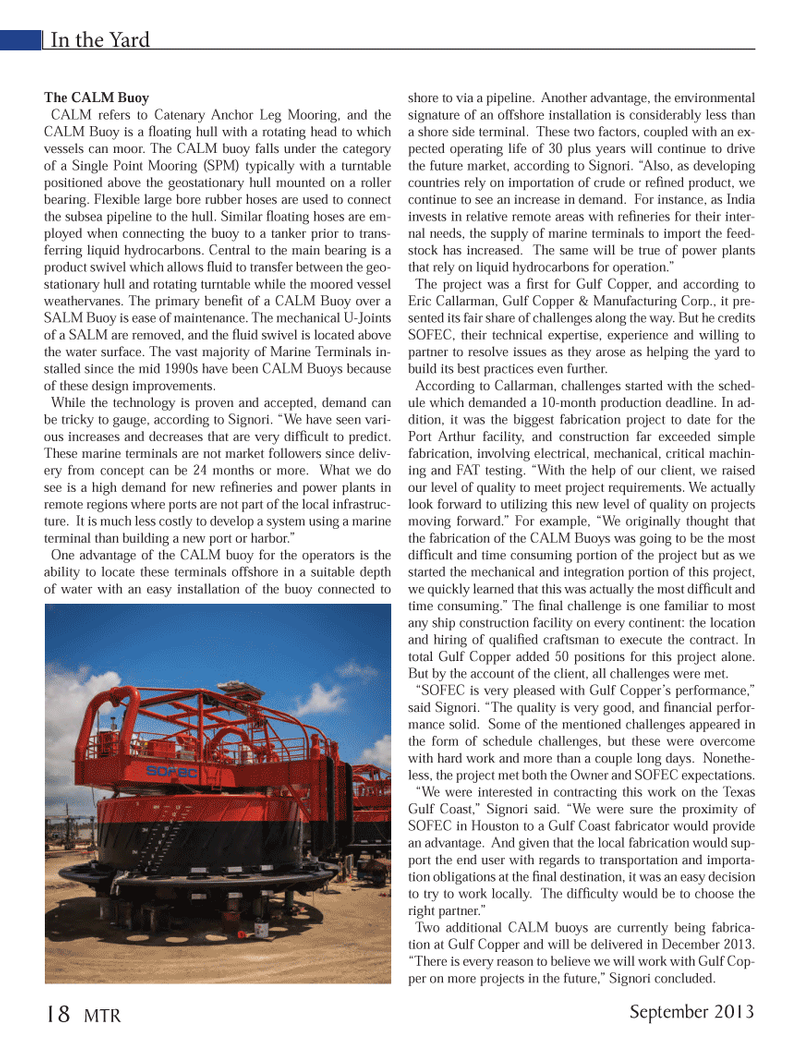
Page 18: of Marine Technology Magazine (September 2013)
Ocean Observation: Gliders, Buoys & Sub-Surface monitoring Networks
Read this page in Pdf, Flash or Html5 edition of September 2013 Marine Technology Magazine
The CALM BuoyCALM refers to Catenary Anchor Leg Mooring, and the CALM Buoy is a ß oating hull with a rotating head to which vessels can moor. The CALM buoy falls under the category of a Single Point Mooring (SPM) typically with a turntable positioned above the geostationary hull mounted on a roller bearing. Flexible large bore rubber hoses are used to connect the subsea pipeline to the hull. Similar ß oating hoses are em- ployed when connecting the buoy to a tanker prior to trans- ferring liquid hydrocarbons. Central to the main bearing is a product swivel which allows ß uid to transfer between the geo- stationary hull and rotating turntable while the moored vessel weathervanes. The primary beneÞ t of a CALM Buoy over a SALM Buoy is ease of maintenance. The mechanical U-Joints of a SALM are removed, and the ß uid swivel is located above the water surface. The vast majority of Marine Terminals in- stalled since the mid 1990s have been CALM Buoys because of these design improvements. While the technology is proven and accepted, demand can be tricky to gauge, according to Signori. ÒWe have seen vari- ous increases and decreases that are very difÞ cult to predict. These marine terminals are not market followers since deliv- ery from concept can be 24 months or more. What we do see is a high demand for new reÞ neries and power plants in remote regions where ports are not part of the local infrastruc- ture. It is much less costly to develop a system using a marine terminal than building a new port or harbor.Ó One advantage of the CALM buoy for the operators is the ability to locate these terminals offshore in a suitable depth of water with an easy installation of the buoy connected to shore to via a pipeline. Another advantage, the environmental signature of an offshore installation is considerably less than a shore side terminal. These two factors, coupled with an ex- pected operating life of 30 plus years will continue to drive the future market, according to Signori. ÒAlso, as developing countries rely on importation of crude or reÞ ned product, we continue to see an increase in demand. For instance, as India invests in relative remote areas with reÞ neries for their inter- nal needs, the supply of marine terminals to import the feed-stock has increased. The same will be true of power plants that rely on liquid hydrocarbons for operation.Ó The project was a Þ rst for Gulf Copper, and according to Eric Callarman, Gulf Copper & Manufacturing Corp., it pre- sented its fair share of challenges along the way. But he credits SOFEC, their technical expertise, experience and willing to partner to resolve issues as they arose as helping the yard to build its best practices even further. According to Callarman, challenges started with the sched-ule which demanded a 10-month production deadline. In ad-dition, it was the biggest fabrication project to date for the Port Arthur facility, and construction far exceeded simple fabrication, involving electrical, mechanical, critical machin- ing and FAT testing. ÒWith the help of our client, we raised our level of quality to meet project requirements. We actually look forward to utilizing this new level of quality on projects moving forward.Ó For example, ÒWe originally thought that the fabrication of the CALM Buoys was going to be the most difÞ cult and time consuming portion of the project but as we started the mechanical and integration portion of this project, we quickly learned that this was actually the most difÞ cult and time consuming.Ó The Þ nal challenge is one familiar to most any ship construction facility on every continent: the location and hiring of qualiÞ ed craftsman to execute the contract. In total Gulf Copper added 50 positions for this project alone. But by the account of the client, all challenges were met.ÒSOFEC is very pleased with Gulf CopperÕs performance,Ó said Signori. ÒThe quality is very good, and Þ nancial perfor- mance solid. Some of the mentioned challenges appeared in the form of schedule challenges, but these were overcome with hard work and more than a couple long days. Nonethe- less, the project met both the Owner and SOFEC expectations. ÒWe were interested in contracting this work on the Texas Gulf Coast,Ó Signori said. ÒWe were sure the proximity of SOFEC in Houston to a Gulf Coast fabricator would provide an advantage. And given that the local fabrication would sup- port the end user with regards to transportation and importa- tion obligations at the Þ nal destination, it was an easy decision to try to work locally. The difÞ culty would be to choose the right partner.Ó Two additional CALM buoys are currently being fabrica- tion at Gulf Copper and will be delivered in December 2013. ÒThere is every reason to believe we will work with Gulf Cop- per on more projects in the future,Ó Signori concluded. In the Yard 18 MTRSeptember 2013MTR #7 (18-33).indd 18MTR #7 (18-33).indd 188/22/2013 10:07:40 AM8/22/2013 10:07:40 AM

 17
17

 19
19
